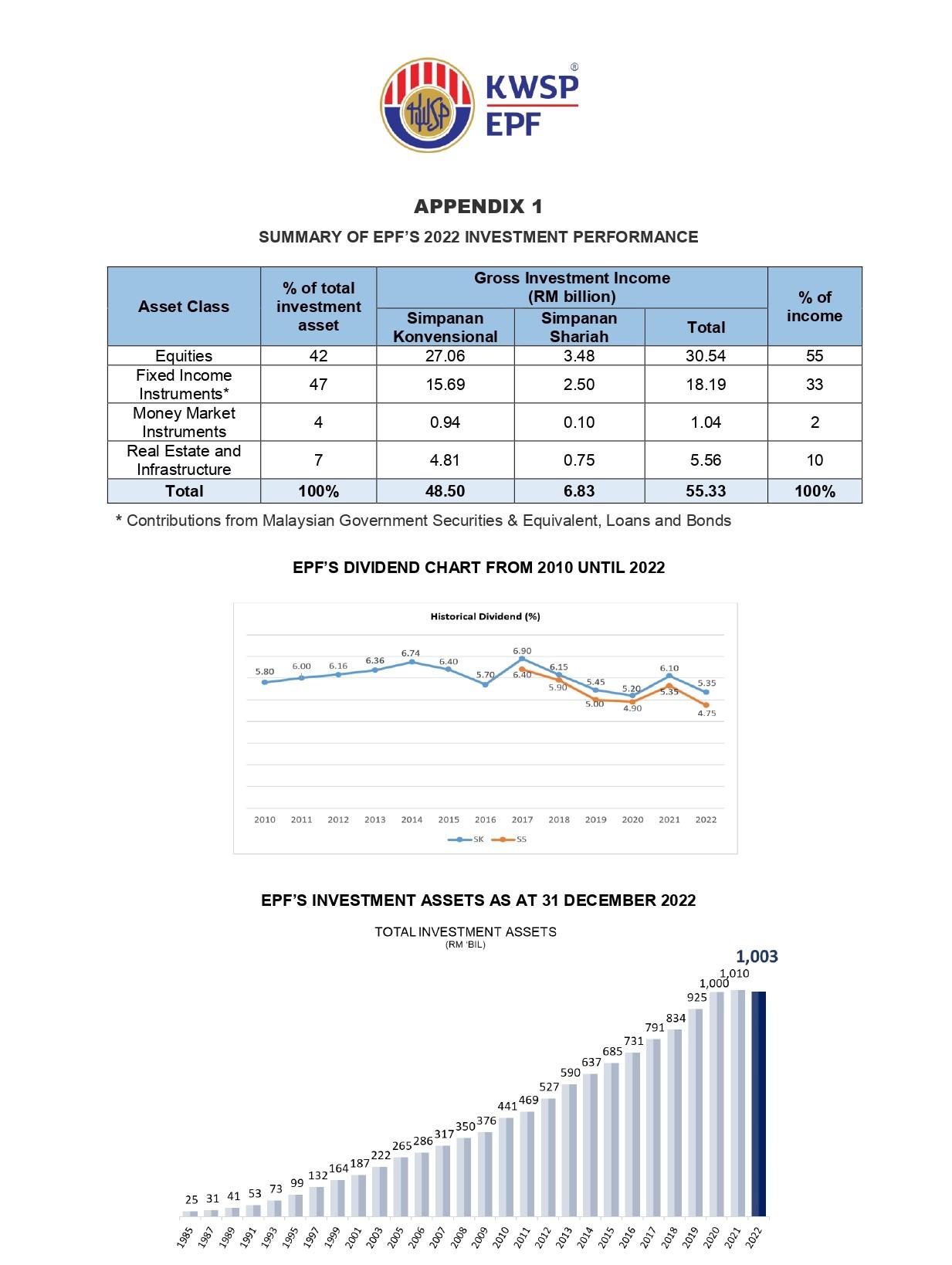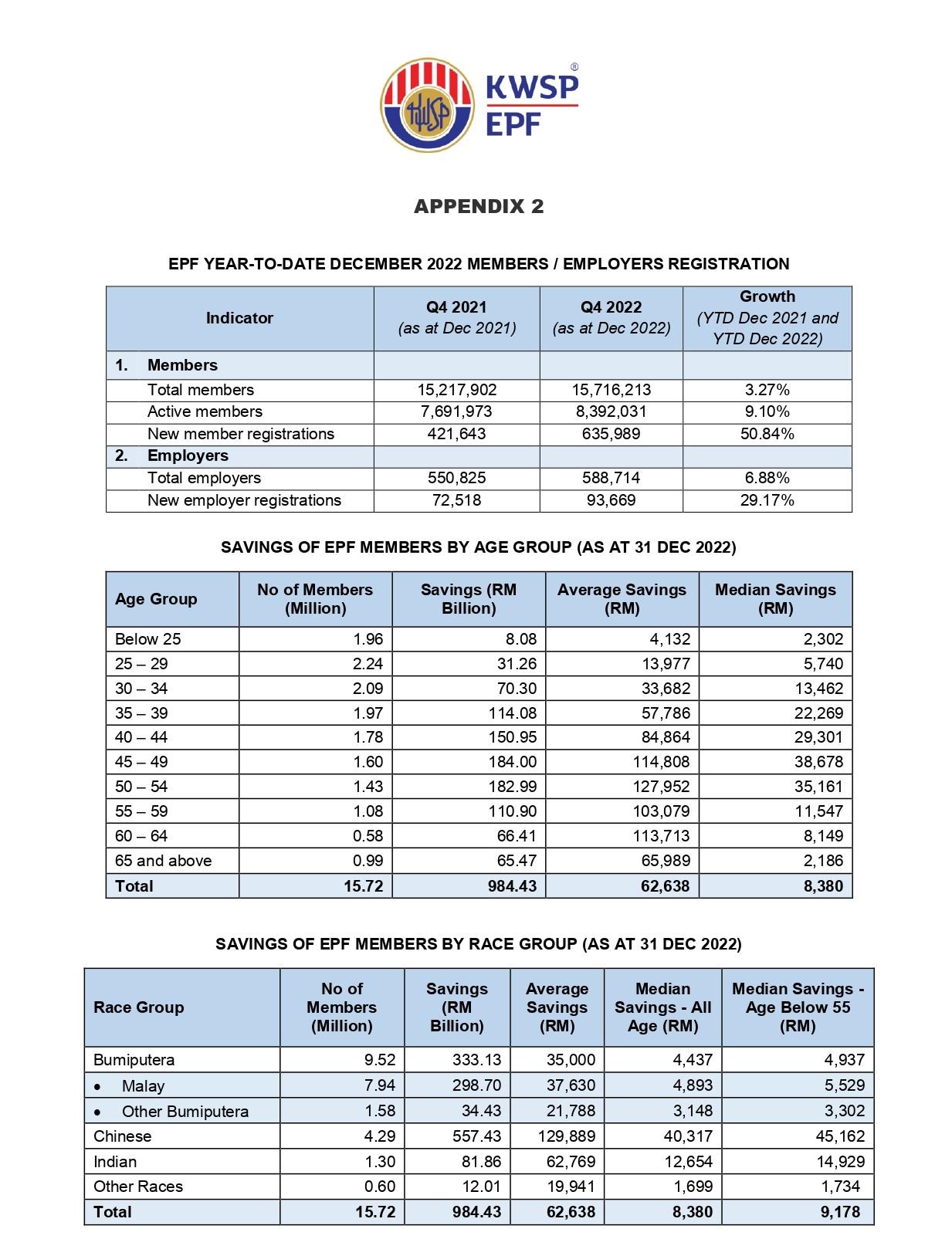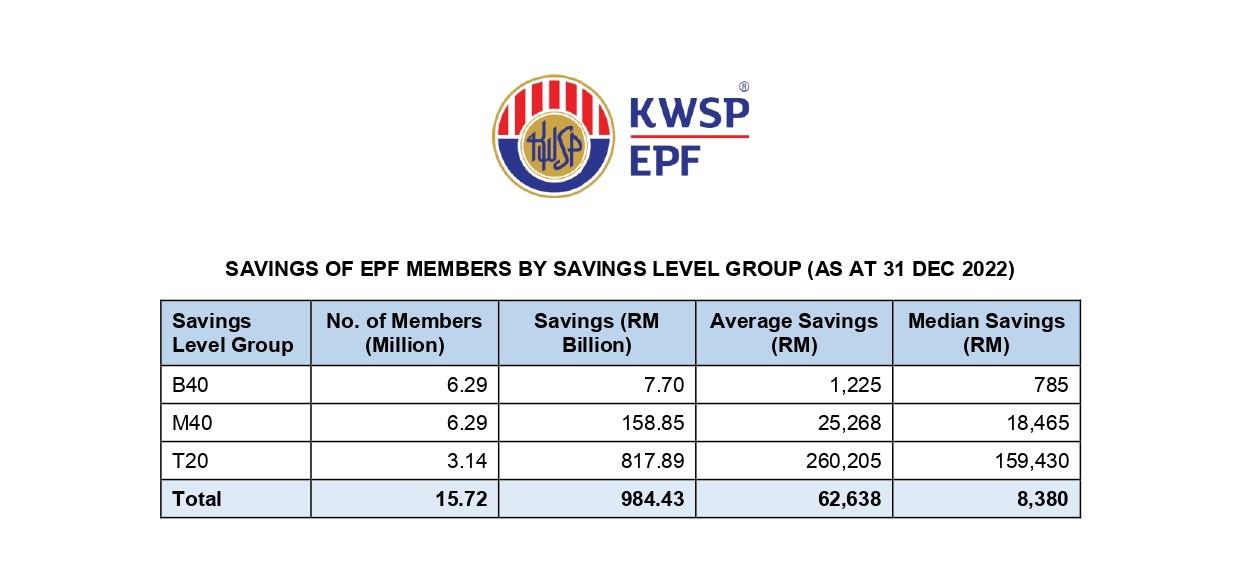EPF delivers competitive returns amid tough investment climate in 2022, reaffirms focus to rebuild members' savings
Declares 5.35% dividend for Simpanan Konvensional and 4.75% for Simpanan Shariah, with total payout of RM51.14 billion.
Payout to benefit more than 15 million EPF members
KWASA DAMANSARA, 4 March 2023: The Employees Provident Fund (EPF) Board today announced a dividend rate of 5.35% for Simpanan Konvensional, with a total payout of RM45.44 billion; and 4.75% for Simpanan Shariah, with a total payout of RM5.70 billion, bringing total payout amount for 2022 to RM51.14 billion.
As at 31 December 2022, the EPF recorded a lower total gross investment income of RM55.33 billion, compared to RM68.89 billion in 2021, driven by high market volatility and lower valuations across equity and fixed income markets.
EPF Chairman Tan Sri Ahmad Badri Mohd Zahir said, “Alhamdulillah, despite the persistent global market downturn in 2022, the EPF investment portfolio maintained its resilience and responded with minimal impact. This was largely due to our overarching strategy that emphasises long term sustainability of investments and returns, in line with the EPF’s Strategic Asset Allocation (SAA). The EPF’s well diversified portfolio and healthy liquidity helped to reduce risk and enabled the fund to maintain investment assets at above RM1.00 trillion and deliver respectable dividend rates for 2022.
“The RM51.14 billion payout will benefit more than 15 million EPF members, which include members from the informal sector who are registered under i-Saraan, an incentive-based voluntary contribution programme. We believe that our members’ retirement savings will benefit from the dividend and our consistent performance, especially when viewed from a long-term perspective. Notwithstanding the economic situation, we will continue to prioritise the long-term success of our investment portfolio and the rebuilding of our members’ retirement savings,” he added.
The financial year 2022 was marked by both slower global growth and high inflation rates, compounded by the tightening of monetary policies by major central banks to reel in inflationary pressure. Fixed income markets did not fare well as bond indices posted negative returns for the year, largely attributed to elevated yields following continued US Federal Reserve rate hikes. Geopolitical instability was also a major factor in driving market gyrations, with the Russian invasion of Ukraine causing a major dislocation in commodity prices, compounded by sabre rattling between the US and China.
The year also saw major global equity benchmark indices wrapping up their worst annual performance since 2008, falling between 20% to over 30% during the year. On the domestic front, the FBM KLCI closed the year 5% lower year-on-year at around the 1,495-point level. The bearish market performance had weighed on the EPF’s earnings generation from equities, which continued to be the EPF’s main income contributor.
Tan Sri Ahmad Badri said notwithstanding the weak performance of the equity markets, not all sectors were affected as some, such as energy, plantation, financial services, and consumer staples, fared reasonably well compared to other sectors. The EPF’s diversification strategy across different sectors and geographies has been effective in capitalising on profit opportunities and generating returns.
The EPF’s SAA, paired with robust liquidity and risk management measures, provides a framework that guides and cushions the fund against difficult conditions, allowing it to deliver the results for 2022.
The EPF’s success in delivering stable and commendable dividends, which consistently surpasses that of other domestic funds, has been instrumental in solidifying its reputation as one of the country’s top institutional investors. This has also contributed to members’ savings, ultimately translating into greater financial security for members’ retirement years.
“Our commitment to building our members’ savings has been the driving force behind our continued success, and we remain steadfast in our dedication to delivering superior dividends and securing our members' financial futures,” said Tan Sri Ahmad Badri.
EPF’s investment portfolio in 2022
For 2022, the EPF recorded a gross investment income of RM55.33 billion, with RM6.83 billion allocated to Simpanan Shariah. The Equities asset class contributed RM30.54 billion, or 55% of the EPF’s total gross income, lower compared to the RM41.06 billion recorded in 2021. Foreign listed equities, which yielded a return on investment (ROI) of 9.27%, continued to be the driver of returns for this asset class.
The private equity portfolio also demonstrated strong performance, recording an ROI of 13.65%. This portfolio generated lower gross investment income compared to 2021, largely due to lower valuations of the underlying assets, apart from lower distributions received for the year.
To ensure long-term portfolio health, the EPF took the prudent measure of writing down RM3.43 billion of its listed equity portfolio in 2022, which was higher than the RM1.15 billion write down recorded in 2021, in line with the volatility in the equity markets. A total of 74% of the total amount came from Shariah-compliant counters that underperformed, which in turn impacted the EPF’s Simpanan Shariah performance for the year.
With almost half of the EPF’s total asset allocation in Fixed Income instruments, comprising Malaysian Government Securities and Equivalent, as well as Loans and Bonds, the retirement fund was able to maintain steady returns. Income from the portfolio contributed RM18.19 billion, or 33% of the EPF’s total gross income. The lower income recorded compared to 2021 can be attributed to lower capital gains driven by increasing yields.
The Real Estate and Infrastructure portfolio’s income of RM5.56 billion continued to play a role as a hedge against inflation, recording an ROI of 10.50%, a spread of 6.13% above the ROI for Fixed Income instruments of 4.37%; whereas income from Money Market instruments came in at RM1.04 billion with an ROI of 3.48%. The performance of these two asset classes is in line with the return expectations set by the SAA.
Despite the numerous macroeconomic challenges and the pandemic related withdrawals totalling RM145 billion, the EPF’s investment assets remained intact and closed at RM1,003 billion in December 2022. Managing the withdrawals was a difficult challenge for the fund, given the need to ensure sufficient liquidity. Even as the EPF successfully navigated through the situation, the cash outflow limited the EPF’s ability to take advantage of investment and profit opportunities for the benefit of all members.
By broad asset class, Fixed Income instruments made up 47% of investment assets, while Equities comprised 42%. Real Estate and Infrastructure as well as Money Market instruments made up 7% and 4% of EPF assets, respectively.
The EPF’s diversification into foreign assets and currencies allowed it to realise additional gains with profits from non-Ringgit sources and added value to the retirement fund’s overall return. As at December 2022, foreign investment made up about 36% of the EPF’s investment assets and contributed 45% of the EPF’s total gross investment income.
Building resilience amidst economic challenges
Growth in the emerging markets and developing economies is expected to decelerate from 3.8% in 2022 to 2.7% in 2023¹, reflecting weaker external demand compounded by high inflation rates, tighter financing policies by central banks, and other domestic and geopolitical headwinds.
Tan Sri Ahmad Badri said, “We anticipate that the 2023 investment climate will continue to be challenging in the short and medium term. The continuing uncertainty underscores the need for a thoughtful approach that focuses on building resilience while aligning with EPF’s longterm investment objectives in accordance with our Strategic Asset Allocation.”
He added that the Budget 2023 recently announced by the Government emphasised efforts to strengthen and support the country’s economic recovery.
“It has been six years since we introduced Simpanan Shariah. We are currently working on enhancing the current business model by fully separating Simpanan Shariah assets from investing alongside shariah-compliant assets in Simpanan Konvensional. By separating, they would have their own independent strategy and differentiated strategic asset allocation which would ensure more optimised, competitive, and sustainable long-term returns for both Simpanan Shariah and Simpanan Konvensional. We target to roll this out in 2024 as mentioned in the recent Budget 2023 announcement,” said Tan Sri Ahmad Badri.
Positive growth of EPF memberships
In its 2022 performance results, the EPF reported a positive rebound in member registrations following the robust recovery in the Malaysian labour market. This helped the fund to record strong growth of new member registrations of 635,989, bringing the total number of EPF members to 15.72 million as at December 2022. Out of that amount, a total of 8.39 million were active members² , which now represent 50% of Malaysia’s 16.7 million labour force³ as at end 2022.
The active member base showed improvement in 2022, surpassing the growth trajectory recorded before the Covid-19 pandemic. This accomplishment enabled the EPF to record a better active-to-inactive member ratio, which increased to 53%:47% as at December 2022, derived from the ratio of active members of 8.39 million against the total number of members at 15.72 million.
“However, the percentage of active members over the total labour force is still relatively low in comparison to the level of old-age social protection coverage globally and as such, the EPF is rolling out initiatives and ramping up its efforts to increase the coverage of the national’s labour force to more than 60%,” said Tan Sri Ahmad Badri.
One of the ongoing efforts in widening the EPF coverage is through i-Saraan, which is designed to allow workers in the informal sector or with no formal income to save for their retirement with the EPF.
In 2022, the number of i-Saraan participants recorded a substantial increment of 191% to 291,743 from 100,254 in 2021, bringing in total Government support of RM33.2 million. Under this programme, eligible members who make voluntary contributions will receive a matching Government contribution of 15% subject to a maximum amount.
As recently announced in the Budget 2023, the Government has raised this maximum amount from RM250 to RM300 per annum as a continuous incentive for i-Saraan members to ramp up their retirement savings.
Overall, the total contribution amount during 2022 increased to RM84.78 billion, an improvement of 16% from 2021. The marked increase reflects improvements in members’ financial capacity resulting from the progressive recovery of incomes, employment, and the economy. It also highlights the continuous trust in the EPF to safeguard members’ lifelong savings.
Evidence of the strong rebound in domestic economic activity can also be seen from the growth of EPF’s employer data where new employer registrations were recorded at 93,669 as at end 2022, bringing the total number of employers registered with the EPF to 588,714.
Retirement security remains key priority
The rapid shift towards greater informal employment compared to formal employment further reinforces the need and urgency to adapt social protection policies and systems to these changes in order to safeguard members’ income security during old age.
The EPF is focusing on three key priorities – adequacy, coverage, and sustainable returns – in its commitment to help rebuild members’ savings and bring the focus back on achieving retirement income security. Through its Jom Tambah campaign, the EPF seeks to get more members to contribute voluntarily any amount into their nest egg via the EPF’s voluntary contribution and voluntary excess programmes.
Concurrently, the EPF is ramping up its Outreach Programme to promote voluntary contributions to build up members’ retirement savings. In 2022, the EPF’s outreach initiatives recorded positive and encouraging growth where the number of members who made voluntary contributions increased 70% to 774,980 in 2022, compared to 445,361 in 2021.
For the year 2023, the EPF will further strengthen its Mobile Team with 26 mobile vehicles and 10 mobile trucks to deploy 143 EPF employees across the country to intensify EPF outreach activities, especially in rural and remote areas. This is in addition to the 15 mobile vehicles and 63 employees already deployed by the Mobile Team.
Due to its critical role in social protection, the EPF is also conducting a holistic review of the EPF scheme, which requires it to heighten engagement activities with both the public and private sectors, as well as industry players.
Tan Sri Ahmad Badri said the EPF will continue to support the implementation of initiatives that seek to catalyse the accumulation and strengthen member’s retirement income, with a view to helping EPF members and future members achieve a dignified retirement.
The crediting of the dividends for both Simpanan Konvensional and Simpanan Shariah will be completed on Saturday, 4 March 2023. Members may check their accounts via i-Akaun or get their statement from EPF’s Self-Service Terminal (SST) nationwide.



References:
¹ Global Economic Prospects report, World Bank
² Active members refer to members who contributed at least once in the last 12 months
³ Labour Force Malaysia, December 2022; Department of Statistics Malaysia, report released on 9th February 2023.
Source: KWSP
RM12.50 / month
- Unlimited access to award-winning journalism
- Comment and share your opinions on all our articles
- Gift interesting stories to your friends
- Tax deductable
